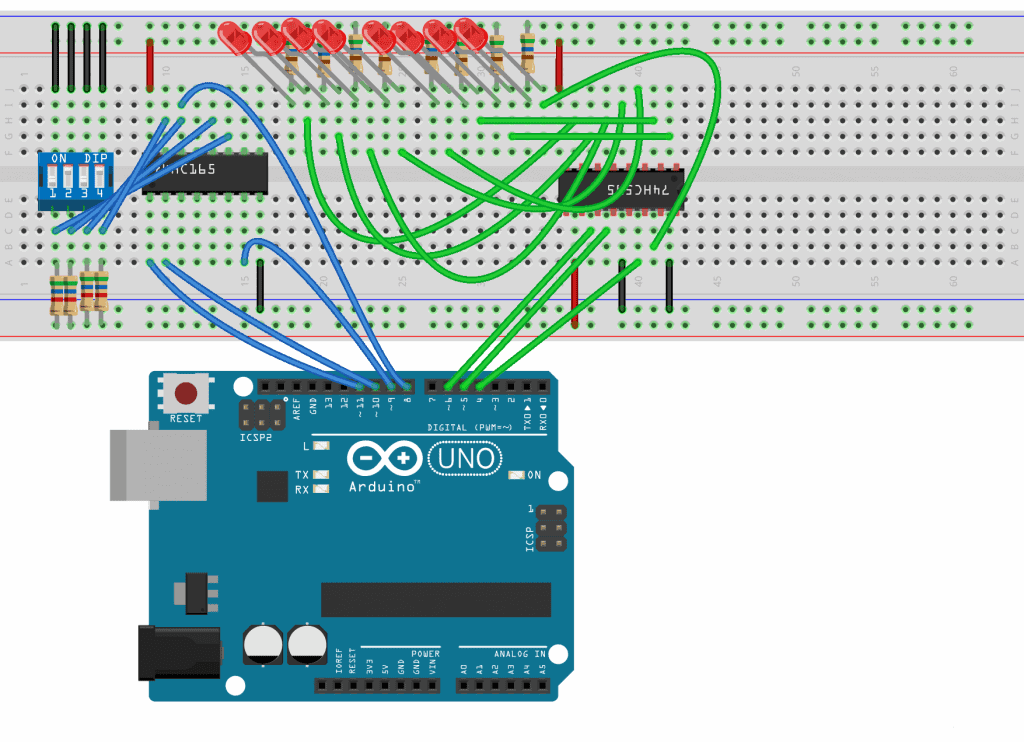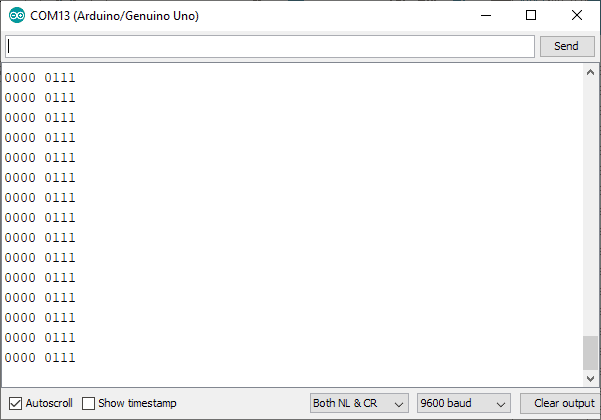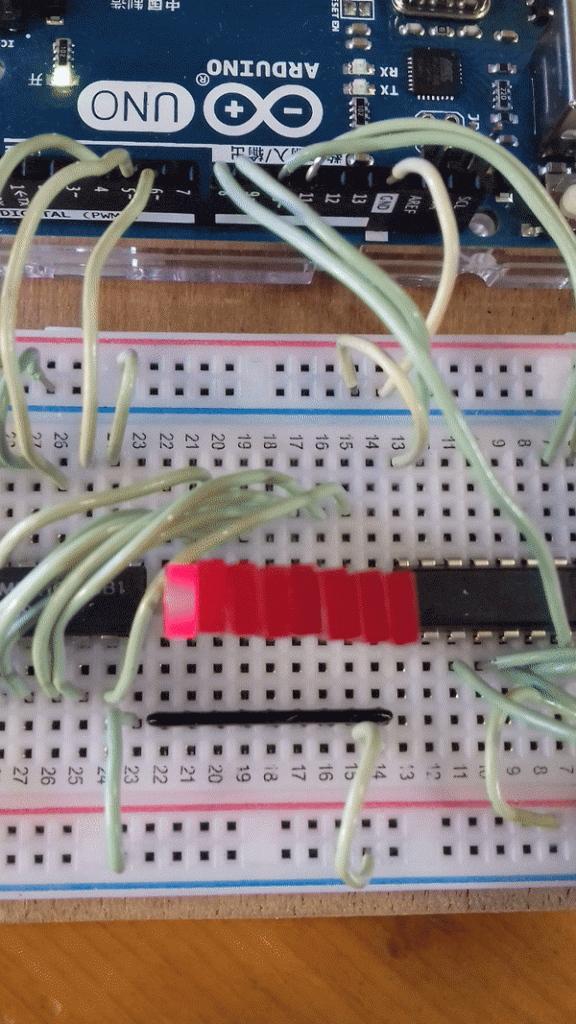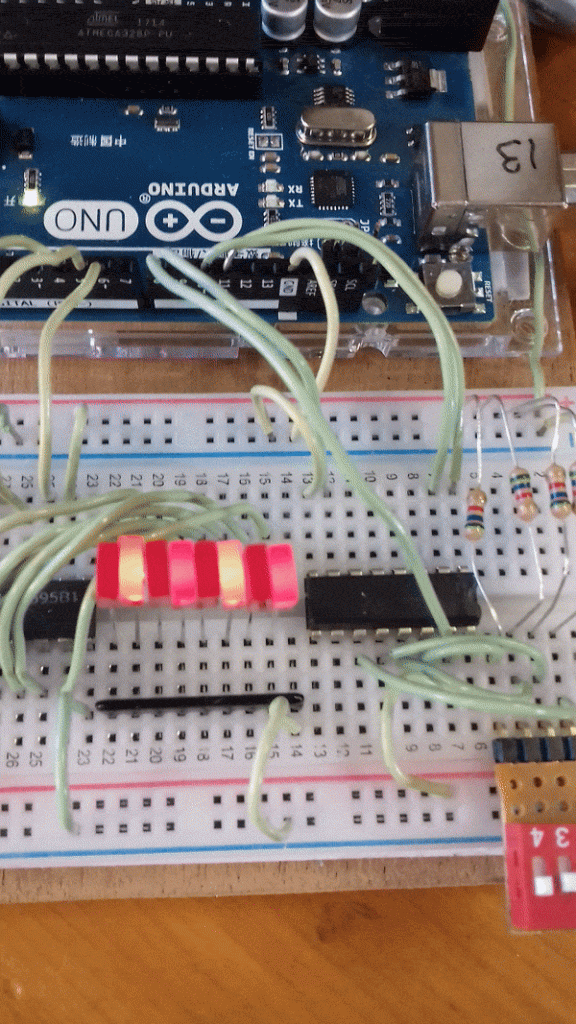How To Write Shift Register Using Digitalwrite For Arduino
Before we dive into our main topic, allow us starting time hash out what are shift registers used for. Shift registers have many uses – converting data from series to parallel format (in communication systems, for instance), and the reverse of this, up/downwards counters, ring counters, sequence generators, fourth dimension delays, and information storage, just to name a few. They are everywhere and very old. Information technology was in 1944 in Bletchly Park in the Britain when Tommy Flowers of the GPO built the globe's showtime shift register using valves (tubes). You tin read more about that hither.

If you take a project which consumes a lot of pins on an Arduino Uno – perhaps you're already using pins for an LCD display, and you demand more than to add an array of 8 LEDs, simply there are not enough pins left – what you demand is a shift register.
In other words, shift registers are sequential logic circuits, capable of storage and transfer of data.
SIPO and PISO Shift Registers
Shift registers come in two main types, a SIPO (Serial-In-Parallel-Out) or PISO (Parallel-In-Series-Out). The standard SIPO fleck is a 74HC595 shift register, and the PISO chip is a 74HC165 shift register. A SIPO is useful for driving a large number of outputs, like LEDs, or vii segment displays, and a PISO is useful for gathering a big number of inputs, like buttons.
Using SIPO and PISO
An understanding of some bitwise Arduino manipulation is helpful to using SIPO and PISO. To illustrate this improve, nosotros volition build some example projects. For sketch 1, we will utilise the PISO 74HC165 connected to 4 input DIP switches. This will read the parallel value on the switches out to the serial port.
For sketch 2, we will use the SIPO 74HC595 to control viii LEDs on the output and brand a simple running calorie-free brandish. And finally, for sketch iii, nosotros volition utilise once again the SIPO 74HC595 to write some patterns to the LEDs, but this time, using a pattern array.
Wiring Up the Shift Registers to the Arduino
Here are the parts you volition demand:
- Arduino Uno
- Jumper wires
- Breadboard
- One 74HC595 SIPO shift annals
- One 74HC165 PISO shift register
- Eight 220 Ohm electric current limiting resistors
- 4 v.6K Ohm pull up resistors
- One 4-position DIP switch
The 74HC165 is the chip on the left, and the 74HC595 is the switch on the right:

To learn more than about the Arduino, check out our Ultimate Guide to the Arduino video class. We teach Arduino programming and circuit edifice techniques that volition prepare y'all to build whatsoever project.
Notes on the Sketches
In that location are no libraries to install. All we need are the three sketches below.

Sketch i is a PISO. Information technology loads the value of the nibble (a nibble is half a byte), where the switches are set at, into the register, and clocks them out serially. The serial output is to the Arduino serial window, merely this might not be apparent. The Arduino volition not print leading zeros on a binary number, and then I accept included a part printBin() that will do this. The function too formats the print with the right infinite betwixt nibbles. Because of the way I wired mine, the data I wanted comes out in the MSN (Virtually Significant Nibble), so I use >>4 to become it into the LSN. All the clocking and shifting is done by pulsing the clockIn and dataIn pins and then using the shiftIn() function.
Sketch 2 is a SIPO. We write a series information stream in past using the initial state of i=0 and so clock that through the register and using bitset() to turn the $.25 on. The function shiftLED() does the hard work of latching and clocking the log for united states.
Sketch 3 is a different arroyo. Hither, a bit design is stored in an assortment, and this is passed on to shiftLED scrap by bit to create a pattern. I accept given y'all two patterns but comment them out one at a time.
Arduino Code for Sketch 1 (PISO)
//reads dip sws and displays on serial monitor // Define Connections to 74HC165 int load = 11; // PL pivot i int clockEnablePin = 8; // CE pin xv int dataIn = nine;// Q7 pivot 7 int clockIn = 10; // CP pivot 2 ///////////////////////////////////// void setup() { Serial.brainstorm(9600); // Setup 74HC165 connections pinMode(load, OUTPUT); pinMode(clockEnablePin, OUTPUT); pinMode(clockIn, OUTPUT); pinMode(dataIn, INPUT); } ///////////////////////////////////// void loop() { // Write pulse to load pin digitalWrite(load, LOW); delayMicroseconds(5); digitalWrite(load, HIGH); delayMicroseconds(5); // Get data from 74HC165 digitalWrite(clockIn, HIGH); digitalWrite(clockEnablePin, Depression); byte incoming = shiftIn(dataIn, clockIn, LSBFIRST); digitalWrite(clockEnablePin, Loftier); // Impress to serial monitor // incoming = incoming & 0B11110000; //mask off and get rid of lsb //not required every bit 0'southward get shifted in incoming = incoming >> 4; //motility msb to lsb printBin(incoming); //note you can invert the logic with ~incoming delay(200); } /////////////////////////////////////////// void printBin(byte inByte) //if you endeavour print 00011101 you will go 1101 as the leading zeros don't print //this prints a bin number with all the leading zeros and a space between nibbles { for (int b = 7; b >= iv; b--) Serial.print(bitRead(inByte, b)); Series.impress(" "); for (int b = 3; b >= 0; b--) Serial.print(bitRead(inByte, b)); //now prints: 0001 1101 Series.println(); //needs a CR at finish } //////////////////////////////////////////// Arduino Code for Sketch 2 (SIPO)
int latchPin = 5; int clkPin = 6; int dataPin = four; byte LED = 0; byte i=0; ////////////////////////////////////////////////////// void setup() { Serial.begin(9600); pinMode(latchPin, OUTPUT); pinMode(dataPin, OUTPUT); pinMode(clkPin, OUTPUT); } ////////////////////////////////////////////////////// void loop() { //single LED running light LED = 0; //lsbit if(i==8) i=0; bitSet(LED, i); Serial.println(i); shiftLED(LED); i++; delay(300); } ////////////////////////////////////////////////// void shiftLED(byte thisLED) { digitalWrite(latchPin, Low); shiftOut(dataPin, clkPin, MSBFIRST, thisLED); digitalWrite(latchPin, Loftier); } ////////////////////////////////////////////// Arduino Code for Sketch three (SIPO With Design Array)
// Define Connections to 74HC595 const int latchPin = v;// ST_CP pin 12 const int clockPin = 6; // SH_CP pivot 11 const int dataPin = 4; // DS pin 14 int pattern[8]; /////////////////////////////////////////////// void setup() { pinMode(latchPin,OUTPUT); pinMode(clockPin,OUTPUT); pinMode(dataPin,OUTPUT); //pattern arrays pattern[0] = B10101010; design[1] = B01010101; design[ii] = B10101010; pattern[3] = B01010101; pattern[4] = B10101010; pattern[5] = B01010101; pattern[six] = B10101010; blueprint[7] = B01010101; // design[0] = B00000001; // design[i] = B00000010; // design[two] = B00000100; // pattern[3] = B00001000; // pattern[4] = B00010000; // pattern[6] = B01000000; // pattern[7] = B10000000; } //////////////////////////////////////////////// void loop() { for(int num = 0; num < 8; num++) { shiftLED(pattern[num]); delay(200); } } ////////////////////////////////////////////// void shiftLED(byte thisLED) { digitalWrite(latchPin, Depression); shiftOut(dataPin, clockPin, MSBFIRST, thisLED); digitalWrite(latchPin, Loftier); } ////////////////////////////////////////////// Output and Results



Hope this article has given you a better idea about what a shift register is and how to use them on the Arduino. Be sure to leave a comment below if you have questions about annihilation!

How To Write Shift Register Using Digitalwrite For Arduino,
Source: https://www.circuitbasics.com/how-to-use-shift-registers-on-the-arduino/
Posted by: leblancalubly.blogspot.com


0 Response to "How To Write Shift Register Using Digitalwrite For Arduino"
Post a Comment